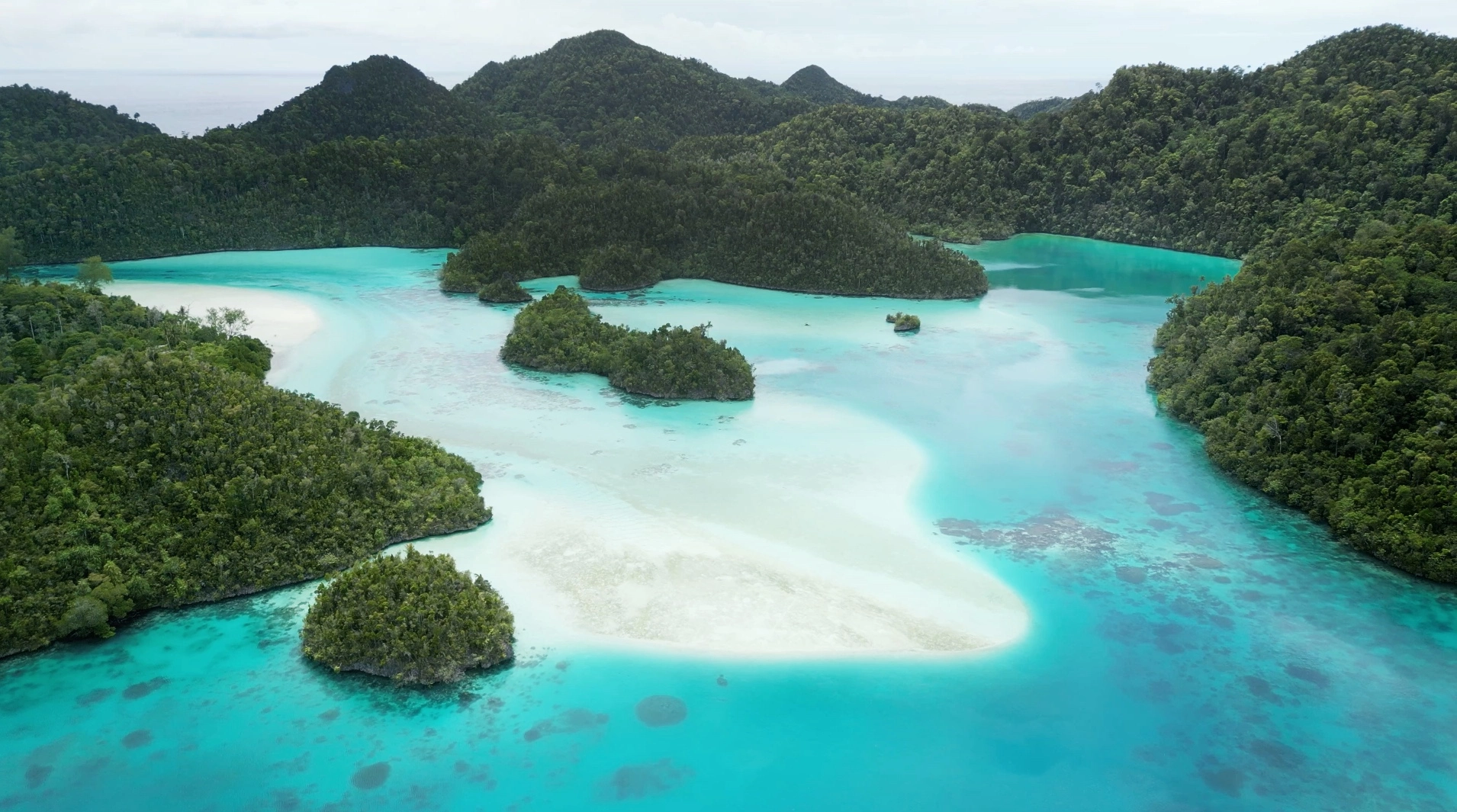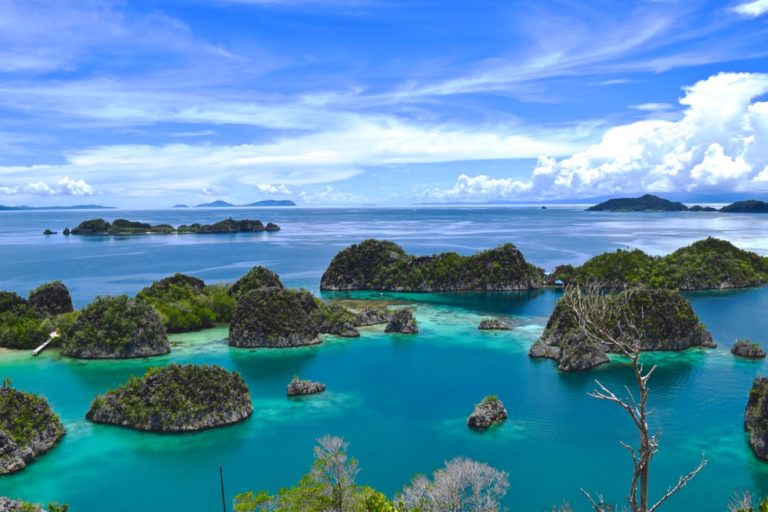
Raja Ampat, meaning "Four Kings" in Indonesian, is a remote archipelago of over 1,500 small islands, cays, and shoals surrounding the four main islands of Misool, Salawati, Batanta, and Waigeo. Located in the heart of Indonesia’s Coral Triangle, this breathtaking region is a diver’s and snorkeler’s paradise, boasting unparalleled biodiversity both above and below the surface. This article serves as your comprehensive guide to planning an unforgettable journey to Raja Ampat, covering its rich history, mesmerizing attractions, practical travel tips, optimal timing, accommodation options, culinary delights, and efficient transportation methods.
A Glimpse into the Past: History and Cultural Significance
The history of Raja Ampat is interwoven with the narrative of the surrounding Indonesian archipelago. Archaeological evidence suggests human presence in the region dating back thousands of years. The islands were once part of the Sultanate of Tidore, a powerful Moluccan kingdom that controlled much of the spice trade in the region. The four main islands, the "Four Kings," were believed to be ruled by individual kings, a legacy that lends the archipelago its name.
Related Articles about Raja Ampat: Unveiling the Jewels of Indonesia’s Coral Triangle:
- Manila: A Tapestry of Time, Taste, and Tropical Charm
- Switzerland: A Journey Through Alpine Majesty and Urban Charm
- Yosemite National Park: A Guide to Experiencing Nature’s Majesty
- Paradise Found: Your Ultimate Guide to Navigating the Maldives Atolls
- Echoes of Empire, Whispers of La Dolce Vita: A Comprehensive Travel Guide to Rome
The arrival of European explorers and traders in the 16th century, primarily the Portuguese and Dutch, marked a significant shift in the region’s history. These powers vied for control of the lucrative spice routes, impacting the local communities and their traditional way of life. The Dutch eventually solidified their dominance, incorporating Raja Ampat into the Dutch East Indies.
Following Indonesia’s independence in 1945, Raja Ampat became part of the newly formed nation. The region remained relatively isolated and untouched for many years, preserving its pristine beauty and traditional cultures. Today, the local Papuan people, the indigenous inhabitants of the islands, continue to maintain their strong connection to the land and the sea, their lives deeply rooted in fishing, agriculture, and traditional crafts. Their warmth and hospitality are integral to the unique charm of Raja Ampat.
Diving into Paradise: Main Attractions and Activities
Raja Ampat is a treasure trove of natural wonders, offering a diverse range of activities for every type of traveler. The sheer density of marine life and the vibrant coral reefs make it a world-renowned destination for diving and snorkeling.
- Diving and Snorkeling: This is the primary draw for most visitors. The waters teem with life, boasting an estimated 75% of all known coral species, over 1,400 fish species, and numerous marine mammals. Popular dive sites include:
- Misool: Known for its stunning underwater landscapes, vibrant coral gardens, and encounters with manta rays, sharks, and turtles. Famous dive sites include Fiabacet, Magic Mountain, and Boo Windows.
- Waigeo: Home to the iconic Kabui Bay, with its dramatic karst formations and hidden lagoons. Divers can explore the famous Sardine Reef and encounter reef sharks and colorful fish.
- Batanta: A haven for macro photography enthusiasts, with diverse critters like nudibranchs, seahorses, and pygmy seahorses.
- Kri Island: Offers easy access to world-class dive sites, including the renowned Manta Point, where you can witness manta rays feeding and cleaning.
- Island Hopping: Explore the diverse landscapes and hidden gems of the archipelago. Visit the iconic Wayag Islands, with their stunning panoramic views, or discover the secluded beaches of Pianemo.
- Kayaking and Paddleboarding: Paddle through the calm waters of the lagoons, explore hidden coves, and marvel at the towering karst formations.
- Birdwatching: Raja Ampat is a haven for birdlife, including the iconic Birds of Paradise. Visit the islands of Gam and Waigeo for opportunities to spot these magnificent creatures.
- Cultural Immersion: Engage with the local communities, learn about their traditions, and experience their warm hospitality. Participate in traditional dances, visit local villages, and savor authentic Papuan cuisine.
- Hiking and Trekking: Explore the lush rainforests of the islands, hike to scenic viewpoints, and discover hidden waterfalls.
- Relaxation and Beachcombing: Unwind on pristine white-sand beaches, soak up the sun, and enjoy the tranquility of this remote paradise.
Navigating the Waters: Travel Tips and Practical Information
Planning a trip to Raja Ampat requires careful consideration and preparation. Here’s a breakdown of essential travel tips:
- Visas: Check visa requirements based on your nationality. Most visitors can obtain a visa on arrival for a fee.
- Best Time to Visit: The dry season, from October to April, is generally considered the best time to visit Raja Ampat. The seas are calmer, visibility is better, and the weather is ideal for diving and snorkeling. However, the shoulder seasons (May-June and September) can also offer good conditions with fewer crowds.
- Getting There: The gateway to Raja Ampat is Sorong, a city in West Papua. You’ll need to fly to Domine Eduard Osok Airport (SOQ) in Sorong. From Sorong, you can reach the main islands by:
- Ferry: Public ferries connect Sorong to Waisai (Waigeo) and other islands. The journey can take several hours and can be crowded.
- Fast Boats: Faster and more comfortable options are available, connecting Sorong to Waisai and other islands. These are typically more expensive than ferries.
- Liveaboard: For the ultimate diving experience, consider a liveaboard. These boats offer all-inclusive packages, allowing you to explore numerous dive sites and stay in comfort.
- Getting Around: Within the islands, transportation options include:
- Speedboats: The most common way to travel between islands and to dive sites.
- Local Boats: Slower and more affordable, often used for shorter distances.
- Motorbikes: Available for rent on some islands.
- Accommodation: Book your accommodation in advance, especially during peak season. Options range from basic homestays to luxurious resorts and liveaboards.
- Packing Essentials:
- Lightweight, breathable clothing
- Swimsuits
- Sunscreen (reef-safe)
- Hat and sunglasses
- Insect repellent
- Reef shoes
- Underwater camera
- Dive gear (if you’re not renting)
- First-aid kit
- Cash (ATMs are limited)
- Health and Safety:
- Consult your doctor about necessary vaccinations and malaria prevention.
- Drink bottled water.
- Be aware of the sun and protect yourself from sunburn.
- Respect the local culture and customs.
- Inform someone of your itinerary.
- Ensure your travel insurance covers diving activities.
- Environmentally Responsible Travel:
- Respect the marine environment. Do not touch or disturb coral reefs.
- Avoid using single-use plastics.
- Support local communities and businesses.
- Leave no trace. Take your trash with you.
Where to Rest Your Head: Hotels and Accommodation
Raja Ampat offers a variety of accommodation options to suit different budgets and preferences.
- Homestays: These are the most affordable option, offering a chance to experience local life and support the community. Homestays are typically located in villages and offer basic amenities.
- Guesthouses: Mid-range options that offer more comfort and amenities than homestays, often located near popular dive sites.
- Resorts: Luxurious options with comfortable rooms, restaurants, and other facilities, often located on private islands.
- Liveaboards: The ultimate experience for divers, offering all-inclusive packages that include accommodation, meals, and diving.
Some popular accommodation options include:
- Misool Eco Resort: A luxurious eco-resort on Misool, known for its commitment to sustainability.
- Raja Ampat Dive Lodge: A dive resort on Kri Island, offering easy access to world-class dive sites.
- Papua Paradise Eco Resort: A secluded resort on Gam Island, known for its pristine beaches and lush surroundings.
- Homestays: Numerous homestays are available throughout the islands, providing a budget-friendly and culturally immersive experience. Check online for options.
A Feast for the Senses: Local Food and Culinary Delights
Papuan cuisine is characterized by its fresh ingredients and simple cooking methods. Seafood is a staple, with fish, squid, and octopus being commonly featured in dishes.
- Ikan Bakar (Grilled Fish): Freshly caught fish grilled to perfection, often served with a spicy sambal (chili paste).
- Sate Ikan (Fish Satay): Skewered and grilled fish marinated in a flavorful blend of spices.
- Papeda: A traditional Papuan staple made from sago starch. It has a sticky, porridge-like consistency and is often served with fish soup or other dishes.
- Gohu Ikan (Raw Fish Salad): Similar to ceviche, this dish features raw fish marinated in lime juice and spices.
- Ubi Jalar (Sweet Potato): A common side dish, often boiled or fried.
- Nasi Goreng (Fried Rice): A popular Indonesian dish, often available in local restaurants.
Transportation in Raja Ampat: Navigating the Archipelago
Transportation in Raja Ampat can be challenging due to the remote location and the island’s vastness. However, with careful planning, you can easily navigate the archipelago.
- Flights: International flights arrive in Jakarta or Bali, and from there, you’ll need to take a domestic flight to Sorong.
- Ferries: Public ferries connect Sorong to Waisai (Waigeo) and other islands. The journey can be long and potentially crowded, but it is an affordable way to travel.
- Fast Boats: Faster and more comfortable options for traveling between Sorong and Waisai, as well as other islands.
- Speedboats: The most common means of transportation between islands and dive sites.
- Local Boats: Slower, cheaper alternatives for short distances.
- Motorbikes: Available for rent on some islands, providing more independence for exploring.
Planning your Raja Ampat adventure requires research and preparation. However, the effort is undoubtedly worth it. This remote paradise offers an experience unlike any other, with its stunning beauty, unparalleled biodiversity, and the warm hospitality of the local people. By following these tips and embracing the adventure, you can create memories that will last a lifetime in the heart of the Coral Triangle.








